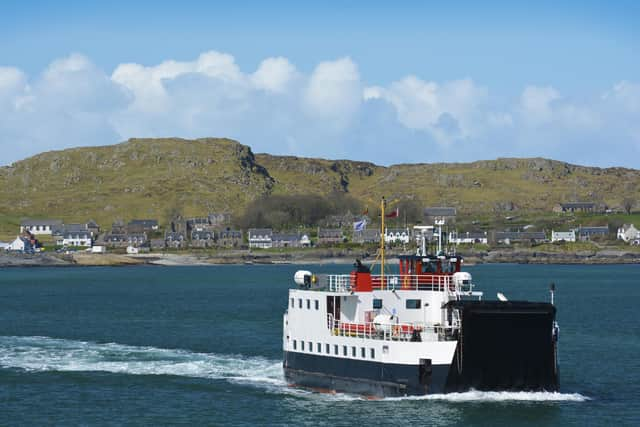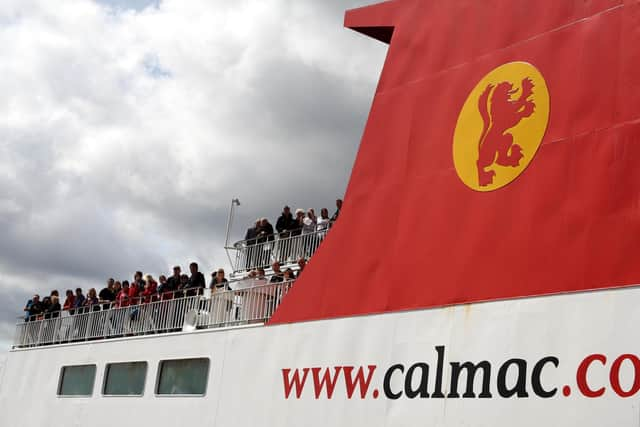Exclusive:CalMac ferry fares could rise up to 40 per cent for island visitors under Scottish Government review
Ferry fares could increase for visitors to Scotland’s islands as part of a major Scottish Government review amid rising demand and costs.
Newly-published proposals suggest that a reduction in ferry fares by ministers nine years ago to bring them into line with road travel costs could be reversed for all but island residents.
Advertisement
Hide AdAdvertisement
Hide AdThe news came as yet another delay to the hugely-late Glen Sannox ferry was signalled by builders Ferguson Marine, which said its completion could be postponed beyond the latest May delivery date because of problems getting parts for the vessel’s novel dual-fuel system.


The Scottish Government described the news as “concerning and extremely disappointing”.
Ministers plan to review ferry fares as part of a new strategy for links to the islands after reduced ticket prices saw demand surge, overwhelming some routes at busy times.
Their so-called “road equivalent tariff” (RET) has cut the average fares for cars by an estimated 40 per cent and for passengers by 34 per cent across CalMac’s west coast network since being extended to all its routes in 2015. Coaches are included in the scheme but not lorries or other vehicles more than 6m long.
The discount has also reduced fares by 20 per cent on NorthLink’s routes between Aberdeen, Orkney and Shetland since 2018.


Transport Scotland’s Islands Connectivity Plan, published on Thursday, said it would “take forward detailed consideration of proposals in the short-term to retain RET for island residents and consider fares for non-islanders, particularly vehicle fares during the summer timetable period".
In the longer term, “dynamic pricing”, in which fares could go up or down to reflect demand for specific sailings, would be examined, which CalMac is already considering.
Foot passenger travel would become free for residents under-22 between islands in the Outer Hebrides, Orkney and Shetland.
Advertisement
Hide AdAdvertisement
Hide AdA spokesperson for the Scottish Government agency said islanders would continue to enjoy the lower fares brought in under RET but there was a need to address “negative and unintended impacts”, which are understood to include drivers unable to get space on some sailings because of increased demand.
The spokesperson told The Scotsman: “RET has been very successful, we will be retaining benefits for islanders and it has largely achieved its policy aims set during its design. However, it has had some negative and unintended impacts.
"The financial background to ferry services today has also evolved and we feel the time is right to take a fresh look at how RET should be applied, and the detail of how it is calculated, as was recommended by the Scottish Parliament’s cross-party net zero, energy and transport committee.
"This will help ensure a successful fare intervention that also gets best public value for money.”
The committee recommended last year that RET should be evaluated before any decision to “reform or extend” it. The group said: “To avoid unintended consequences, this evaluation should include modelling for the increased traffic this may produce, associated costs of demand on island infrastructure and the vessels/services required to mitigate potential capacity issues this could cause to existing services.”
Mull and Iona Ferry Committee chair Joe Reade said ferry operating costs should be cut and ferry capacity increased instead.
He said: “Because advances have not been made to lower costs, nor capacity increased to meet growing demand, Transport Scotland is now looking at raising fares to cover more of CalMac’s exorbitant operating costs and use ‘demand management’ to dissuade travellers from using high-demand sailings – put the price up.
"It is a very short-sighted reaction to a structural problem – our ferries deliver poor service and low capacity at very high cost.”
Advertisement
Hide AdAdvertisement
Hide AdBill Calderwood, secretary of the Isle of Arran Ferry Committee, said: "We do not believe that fares are the way to manage demand. This is a subject that needs significant review.”
Scottish Conservatives transport spokesperson Graham Simpson said: “Any increase in fares is bad news for islanders and their businesses, who depend on people travelling from elsewhere.
"But it is reasonable that those who live there should pay less, given the additional costs they face because of the SNP-Green Government’s underfunding of essential services, and their failure to maintain lifeline ferries.”
Alex Rowley, his Scottish Labour counterpart, said: “Any discussion on the future of fares must have the voices and concerns of island communities at its heart."
Orkney Liberal Democrat MSP Liam McArthur said: “The SNP initially introduced RET on Western Isles routes as a crude electoral bribe back in 2008. Even after it was then rolled out to all west coast routes, Orkney and Shetland services continued to be excluded.
"Having never taken the time to work out the true costs or impact of delivering RET fairly across all routes, SNP ministers have happily played one island community off against another.
“Now they have run out of money, Ministers are proposing to row back on RET for non-islanders. Before they start introducing cuts, however, ministers must finally allow those relying on Pentland Firth services [between Caithness and Orkney] to enjoy the benefits of cheaper ferry fares, even if it only applies to islanders.”
Meantime, Ferguson Marine chief executive David Tydeman told MSPs on Friday that Glen Sannox’s parts delay “will have a bearing on the final handover”.
Advertisement
Hide AdAdvertisement
Hide AdThe ferry will need two months of CalMac trials once it finally leaves the yard before entering passenger service on the main Arran route to Brodick, which is scheduled to be at some stage this summer.
In an update following a Ferguson Marine review of the beleaguered project, which is six years late and three times over budget, Mr Tydeman said the yard was “evaluating the risks to further slippage on the planned late May handover date for Glen Sannox, the cascade impacts onto Hull 802 [sister ferry Glen Rosa] and the overall costs to complete impacts for both ships.”
He blamed the latest setback on switching to a new supplier after a delay in the delivery of piping for the ferry’s liqueified natural gas (LNG) fuel, which it will use as well as diesel.
In a separate setback, a back-up berth in Ardrossan harbour used by some CalMac ferries on the Brodick route has been permanently closed by owner Peel Ports because of its poor state, which will restrict which vessels can operate on the route.
Sailings are due to temporarily switch to Troon for several years when Glen Sannox enters service while the harbour is upgraded to accommodate the larger ferry.
However, the upgrade has still to be agreed and Transport Secretary Mairi McAllan was unable to confirm this week that Ardrossan would be the long-term port for the route, which is one CalMac’s three busiest.
Comments
Want to join the conversation? Please or to comment on this article.